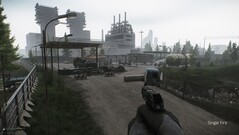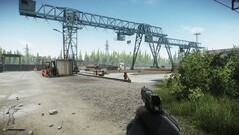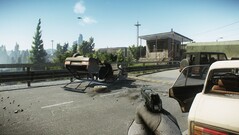Escape from Tarkov Notebook und Desktop Benchmarks
Technik
Escape from Tarkov stammt vom russischen Entwickler Battlestate Games, der den Titel auf seiner hauseigenen Plattform, dem Battlestate Games Launcher, vertreibt. Über diesen lässt sich das Spiel downloaden und starten. Mit einer Größe von rund 17 GB (ca. 10 GB Download) ist Escape from Tarkov überraschend klein. Andere Shooter verschlingen gut und gern über 50 GB.
Leider scheinen die Plattform und die Technik noch etwas unausgereift zu sein. So hatten wir im Testverlauf nicht nur mit einigen Verbindungsproblemen bzw. Abbrüchen zu kämpfen, sondern sahen uns auch diversen anderen (teils sehr kryptischen) Fehlermeldungen konfrontiert.
Sofern man es ins Spiel geschafft hat, erwartet Tuning-Fans ein sehr aufgeräumtes Grafikmenü. Während man im oberen Bereich die Auflösung, den Bildmodus, das Seitenverhältnis und die vertikale Synchronisation anpassen kann, tummeln sich im unteren Bereich 17 Detailsettings, welche sich in einem Rutsch per Overall Graphics Quality regeln lassen (wobei selbst auf Ultra nicht jedes Setting auf Anschlag steht). Mit Ausnahme der Texturqualität werden alle Änderungen ohne Neustart übernommen.
Das gebotene Grafiklevel würden wir – je nach Stufe – als ordentlich bis gut bezeichnen. Escape from Tarkov kann optisch locker mit anderen Genrevertretern wie beispielsweise Arma und PUBG mithalten. Dank der dynamischen Tages- und Nachtzeiten sowie der Wetterwechsel erzeugt der Titel auch abseits der reinen Grafik eine stimmige Atmosphäre.
Benchmark
Für unsere Benchmarks greifen wir auf den optionalen Offline-Modus zurück, der ohne menschliche Gegner und – auf Wunsch – ohne SCAVs (= NPCs) auskommt. Die Geschwindigkeitsmessungen finden bei Tag auf der Map Customs statt, die für Anfänger empfohlen wird und neben Waldstücken auch mehrere Straßen und Gebäude beherbergt. Da der Spawnpunkt variabel ist, lassen sich die Abläufe leider nicht 1:1 reproduzieren, weshalb wir einfach für rund 30 Sekunden „durch die Gegend laufen“ und die Framerate per Fraps aufzeichnen.
Um mehr als 60 Bilder pro Sekunde zu erhalten, muss man im Grafikmenü übrigens das Game FPS Limit anheben. Der maximale Wert beträgt 120. Hinweis: Aktuell befindet sich Escape from Tarkov in der Betaphase. In der finalen Version (falls sie denn eines Tages erscheint) kann die Performance natürlich abweichen.
Resultate
FHD (1.920 x 1.080)
Wie im Einleitungstext angedeutet, fallen die Systemvoraussetzungen ziemlich moderat aus. Um den Titel mit 1.920 x 1.080 Pixeln und dem Preset Medium zocken zu können, reicht bereits eine (ältere) Midrange-GPU auf dem Niveau der GeForce GTX 1050. Für das Preset High sollte es eine GeForce GTX 1050 Ti oder besser sein, das Preset Ultra wünscht sich dagegen mindestens eine GeForce GTX 1650.
| Escape from Tarkov | |
| 1920x1080 Medium Preset 1920x1080 High Preset 1920x1080 Ultra Preset | |
| NVIDIA GeForce GTX 1070 Mobile | |
| NVIDIA GeForce GTX 1080 Mobile | |
| NVIDIA GeForce RTX 2080 Ti (Desktop) | |
| NVIDIA GeForce RTX 2060 Mobile | |
| NVIDIA GeForce RTX 2070 Mobile | |
| NVIDIA GeForce RTX 2080 Mobile | |
| NVIDIA GeForce RTX 2060 (Desktop) | |
| NVIDIA GeForce RTX 2070 (Desktop) | |
| NVIDIA GeForce RTX 2080 (Desktop) | |
| NVIDIA GeForce GTX 1660 Ti Mobile | |
| AMD Radeon RX 5500M | |
| NVIDIA GeForce GTX 1060 Mobile | |
| NVIDIA GeForce GTX 1650 Mobile | |
| NVIDIA GeForce GTX 1050 (Desktop) | |
| NVIDIA GeForce GTX 1050 Ti Mobile | |
| NVIDIA GeForce GTX 1050 Mobile | |
| AMD Radeon RX 460 (Desktop) | |
| NVIDIA GeForce GTX 1050 Ti (Desktop) | |
| AMD Radeon R7 370 | |
| NVIDIA GeForce GTX 1080 Ti (Desktop) | |
QHD (2.560 x 1.440)
Eine High-End-GPU ist erst bei höheren Auflösungen als Full-HD nötig. Für eine Mischung aus 2.560 x 1.440 Pixeln und dem Ultra-Preset bietet sich eine GeForce GTX 1660 Ti und aufwärts an.
| Escape from Tarkov | |
| 2560x1440 Ultra Preset | |
| NVIDIA GeForce RTX 2080 Ti (Desktop), i9-9900K | |
| NVIDIA GeForce RTX 2080 (Desktop), i9-9900K | |
| NVIDIA GeForce GTX 1080 Ti (Desktop), i7-8086K | |
| NVIDIA GeForce RTX 2070 (Desktop), i9-9900K | |
| NVIDIA GeForce RTX 2080 Mobile, i9-9900K | |
| NVIDIA GeForce GTX 1080 Mobile, i7-7820HK | |
| NVIDIA GeForce RTX 2060 (Desktop), i9-9900K | |
| NVIDIA GeForce RTX 2070 Mobile, i7-9750H | |
| NVIDIA GeForce GTX 1070 Mobile, 6820HK | |
| NVIDIA GeForce RTX 2060 Mobile, i7-9750H | |
| NVIDIA GeForce GTX 1660 Ti Mobile, i7-9750H | |
| AMD Radeon RX 5500M, R7 3750H | |
| NVIDIA GeForce GTX 1060 Mobile, 6820HK | |
| NVIDIA GeForce GTX 1650 Mobile, i7-9750H | |
| NVIDIA GeForce GTX 1050 Ti Mobile, i7-7700HQ | |
| NVIDIA GeForce GTX 1050 Mobile, i7-7700HQ | |
UHD (3.840 x 2.160)
Richtig rechenintensiv wird Escape from Tarkov nur im 4K-Bereich. Wenn es volle Details und 3.840 x 2.160 Pixel sein sollen, bringt bei Notebooks aktuell nur Nvidias Spitzenmodell, die GeForce RTX 2080, genug Power mit.
| Escape from Tarkov | |
| 3840x2160 Ultra Preset | |
| NVIDIA GeForce RTX 2080 Ti (Desktop), i9-9900K | |
| NVIDIA GeForce RTX 2080 (Desktop), i9-9900K | |
| NVIDIA GeForce GTX 1080 Ti (Desktop), i7-8086K | |
| NVIDIA GeForce RTX 2080 Mobile, i9-9900K | |
| NVIDIA GeForce RTX 2070 (Desktop), i9-9900K | |
| NVIDIA GeForce GTX 1080 Mobile, i7-7820HK | |
| NVIDIA GeForce RTX 2060 (Desktop), i9-9900K | |
| NVIDIA GeForce RTX 2070 Mobile, i7-9750H | |
| NVIDIA GeForce GTX 1070 Mobile, 6820HK | |
| NVIDIA GeForce RTX 2060 Mobile, i7-9750H | |
| NVIDIA GeForce GTX 1660 Ti Mobile, i7-9750H | |
| AMD Radeon RX 5500M, R7 3750H | |
| NVIDIA GeForce GTX 1060 Mobile, 6820HK | |
| NVIDIA GeForce GTX 1650 Mobile, i7-9750H | |
| NVIDIA GeForce GTX 1050 Ti Mobile, i7-7700HQ | |
| NVIDIA GeForce GTX 1050 Mobile, i7-7700HQ | |
Hinweis
Da Gamingtests sehr zeitaufwändig sind und oft durch Installations- bzw. Aktivierungslimits behindert werden, können wir Ihnen zur Veröffentlichung der Artikel nur einen Teil der Benchmarks liefern. Weitere Grafikkarten werden jeweils in den kommenden Tagen und Wochen eingebaut.
Übersicht
Testsysteme
| Gerät | Grafikkarte | Prozessor | Arbeitsspeicher | Betriebssystem |
|---|---|---|---|---|
| Desktop-PC I | MSI GeForce RTX 2080 Ti (11 GB GDDR6) MSI GeForce RTX 2080 (8 GB GDDR6) MSI GeForce RTX 2070 (8 GB GDDR6) MSI GeForce RTX 2060 (6 GB GDDR6) |
Intel Core i9-9900K | 4 x 8 GB DDR4 | Windows 10 64 Bit |
| Desktop-PC II | Nvidia GeForce GTX 1080 Ti (11 GB GDDR5X) Asus GeForce GTX 980 Ti (6 GB GDDR5) XFX Radeon R9 Fury (4 GB HBM) Sapphire Radeon R9 290X (4 GB GDDR5) Sapphire Radeon R9 280X (3 GB GDDR5) MSI Radeon R7 370 (2 GB GDDR5) |
Intel Core i7-7740X | 2 x 8 GB DDR4 | Windows 10 64 Bit |
| Desktop-PC III | Nvidia Titan RTX (24 GB GDDR6) Nvidia GeForce RTX 2080 Super (8 GB GDDR6) Nvidia GeForce RTX 2070 Super (8 GB GDDR6)Nvidia GeForce RTX 2060 Super (8 GB GDDR6)KFA2 GeForce RTX 2060 Super (8 GB GDDR6)Nvidia Titan X (Pascal) (12 GB GDDR5X) KFA2 GeForce GTX 1660 Super (6 GB GDDR6) PNY GeForce GTX 1660 (6 GB GDDR5) Gainward GeForce GTX 1650 (4 GB GDDR5) Zotac GeForce GT 1030 (2 GB GDDR5) AMD Radeon RX 5700 XT (8 GB GDDR6) AMD Radeon RX 5700 (8 GB GDDR6) AMD Radeon RX Vega 64 (8 GB HBM2) XFX AMD Radeon RX 590 (8 GB GDDR5) |
AMD Ryzen 9 3900X | 2 x 8 GB DDR4 | Windows 10 64 Bit |
| MSI GT76 | Nvidia GeForce RTX 2080 (8 GB GDDR6) | Intel Core i9-9900K | 2 x 16 GB DDR4 | Windows 10 64 Bit |
| MSI GP65 | Nvidia GeForce RTX 2070 (8 GB GDDR6) | Intel Core i7-9750H | 2 x 16 GB DDR4 | Windows 10 64 Bit |
| MSI GE65 | Nvidia GeForce RTX 2060 (6 GB GDDR6) | Intel Core i7-9750H | 2 x 8 GB DDR4 | Windows 10 64 Bit |
| MSI GP65 | Nvidia GeForce GTX 1660 Ti (6 GB GDDR6) | Intel Core i7-9750H | 2 x 16 GB DDR4 | Windows 10 64 Bit |
| MSI GP75 | Nvidia GeForce GTX 1650 (4 GB GDDR5) | Intel Core i7-9750H | 2 x 8 GB DDR4 | Windows 10 64 Bit |
| Alienware 17 R4 | Nvidia GeForce GTX 1080 (8 GB GDDR5X) | Intel Core i7-7820HK | 2 x 16 GB DDR4 | Windows 10 64 Bit |
| Asus G752VS | Nvidia GeForce GTX 1070 (8 GB GDDR5) | Intel Core i7-6820HK | 2 x 16 GB DDR4 | Windows 10 64 Bit |
| MSI GT62VR | Nvidia GeForce GTX 1060 (6 GB GDDR5) | Intel Core i7-6820HK | 2 x 8 GB DDR4 | Windows 10 64 Bit |
| MSI GE72 | Nvidia GeForce GTX 1050 Ti (2 GB GDDR5) | Intel Core i7-7700HQ | 2 x 4 GB DDR4 | Windows 10 64 Bit |
| MSI GL62 | Nvidia GeForce GTX 1050 (2 GB GDDR5) | Intel Core i7-7700HQ | 2 x 4 GB DDR4 | Windows 10 64 Bit |
| MSI GE72 | Nvidia GeForce GTX 965M (2 GB GDDR5) | Intel Core i7-6700HQ | 1 x 8 GB DDR4 | Windows 10 64 Bit |
| MSI PE60 | Nvidia GeForce GTX 950M (2 GB GDDR5) | Intel Core i7-6700HQ | 2 x 4 GB DDR4 | Windows 10 64 Bit |
| MSI CX72 | Nvidia GeForce 940MX (2 GB DDR3) | Intel Core i7-6700HQ | 2 x 8 GB DDR4 | Windows 10 64 Bit |
| MSI GP62 | Nvidia GeForce 940M (2 GB DDR3) | Intel Core i7-5700HQ | 1 x 8 GB DDR3 | Windows 10 64 Bit |
| MSI CX61 | Nvidia GeForce 920M (2 GB DDR3) | Intel Celeron 2970M | 1 x 8 GB DDR3 | Windows 10 64 Bit |
| MSI Alpha 15 | AMD Radeon RX 5500M (4 GB GDDR6) | AMD Ryzen 7 3750H | 2 x 8 GB DDR4 | Windows 10 64 Bit |
| Honor Magicbook | AMD Radeon RX Vega 8 | AMD Ryzen 5 2500U | 1 x 8 GB DDR4 | Windows 10 64 Bit |
| 4K Monitore | Nvidia Treiber | AMD Treiber |
|---|---|---|
| Asus PB287Q, Philips Brilliance 329P9H | ForceWare 442.19 | Adrenalin 20.2.1 |



















